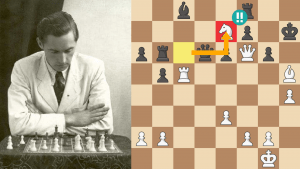
Test Your Chess Understanding
First, let me implore you to read the notes to the puzzles: The prose and variations are what makes this new series worthwhile, so PLEASE try and solve the puzzle and then go back (whether you got it right or not), click on the little question mark on the bottom border of the board, read the instructional prose, and enjoy the variations.
This is the first of a long series of articles dedicated to Chess.com members who want to get a glimpse of their strengths and weaknesses. I’ve been inundated by members who want me to say something about their games/weaknesses, so instead of looking at whole games, I’ll point out a key moment in a game or two and then move on to another person.
The material I offer should prove instructive for players from a 1000 rating to Class A (1800s-1900s).
One final thing: nobody owns a chess game, even if you played it! So if you lead me to your games, you might discover (in the years ahead) that a position of yours has (perhaps, maybe, who knows) found its way into one of my books.

PUZZLE ONE
In our first test, Black has just played 12...e5 threatening a winning fork with ...e5-e4. What should White do?
PUZZLE TWO
The opening hasn’t been kind for White and now Black has more than one promising choice. Can you see Black’s various plusses?
PUZZLE THREE
In this pleasant position White has an advantage in central space, though Black’s position is solid. And, of course, Black threatens to chop the pawn on a2 by ...Bxa2.
In the game White played 19.d5, gaining more space, ending Black’s threat of ...Bxa2, and also attacking Black’s bishop. Is 19.d5 a good idea, a bad idea, reasonable but not great, or inferior due to a hidden blockbuster opportunity that White had?
Returning to our original position, let’s look at a couple alternatives to 19.d5:
PUZZLE FOUR
White sacrificed a pawn for a lead in development. The fact that Black’s king is in the center while White’s is safely castled (Meaning no worries for the white king while the kingside rook can come into play!) is a big plus.
How should White continue? Keep in mind that having these plusses doesn’t necessarily mean you’re winning or even better. But it DOES mean that you need to recognize the situation and play according to it.






